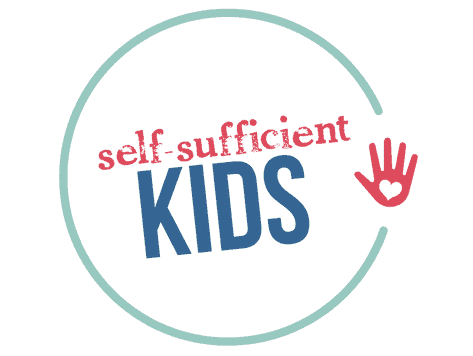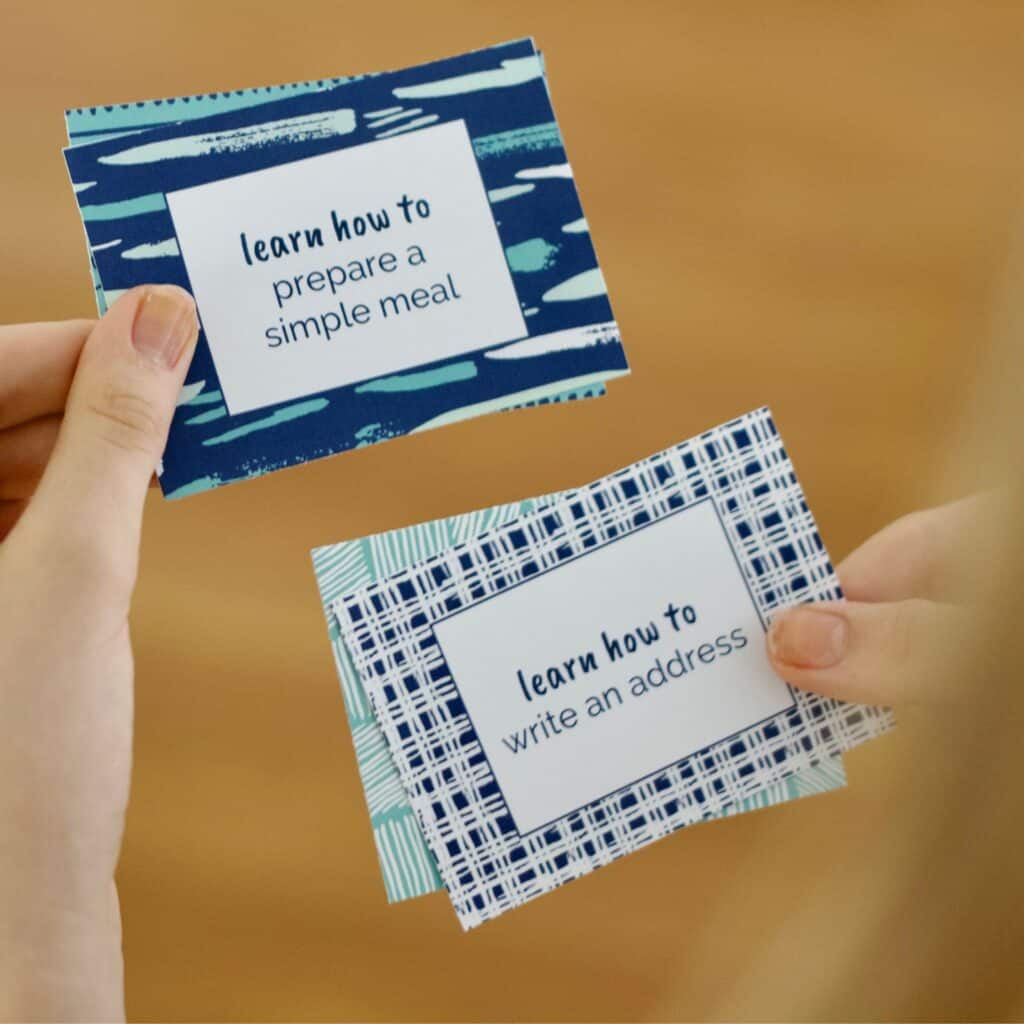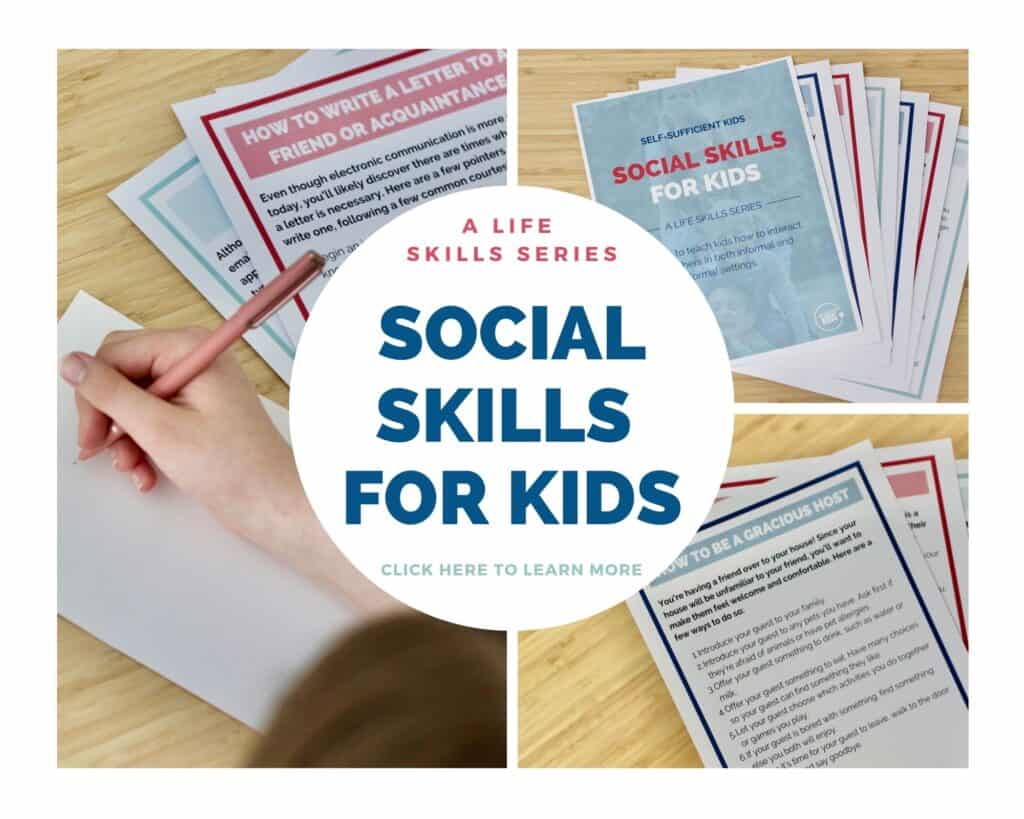24 Basic Table Manners All Kids Need to Learn
Learning basic table manners helps prepare kids for eating with others and a variety of social situations when they’re older.

When we think of life skills our kids will need, table manners usually don’t immediately come to mind.
In fact, good table manners might seem more like a “nice to have” life skill to teach our kids.
But following proper etiquette when eating is more important than it might at first seem.
When our children are in social situations or eventually find themselves at a job interview that includes a meal, knowing the proper way to behave will make a big difference in how they’re perceived.
If you’ve ever had the unpleasant experience of sitting next to someone as they chew with their mouth open, you know how distracting that can be.
Instead of focusing on the person and what they’re saying, you can’t think of anything other than the gross noise coming from their mouth.
It can also be distracting if someone reaches far across the table to reach the bread basket, keeps their dirty napkin on the table instead of their lap, or is the only person who fails to bring their dirty dishes up to the sink.
Table manners make a difference. But the good news is, if we’re eating regular meals with our children (even once a week!) we can begin to teach them proper etiquette and behavior.
When it comes to teaching table manners, children will follow our lead
As in nearly every aspect of parenting, our children learn more from what we model for them than what we tell them.
So if we only demonstrate poor table manners at the family dinner table, our kids are likely to follow and not realize that more could be expected of them in other situations.
That said, explaining good manners to our kids will reinforce what they’re seeing us demonstrate and solidify the lesson further.
Remember too that some children require repetition. Telling them once or even five times to put their napkin on their lap may not make it a habit. Kids will need our patience as they learn these skills.
And also remember that often our children are listening to our guidance and may be more likely to put it into practice outside of the home rather than in the comfort of their own home.
At what age should kids begin to learn table manners?
There’s no age limit to when kids can begin to learn table manners.
Of course, we can’t expect much from children under two years old.
Nor can we reasonably expect younger children to sit still, keep a napkin on their lap and not hop up from the table from time to time.
But that doesn’t mean we can’t still discuss table manners with our young children, as long as we keep our expectations for progress fairly low.
By the time children are anywhere from eight to ten years old, we can expect more from them at mealtime although repetition will most likely still be needed.
Ready to teach your child life skills? These cards can help! Each card in this eighty-one deck contains a skill your child can begin practicing with you or on their own. Click here or the image below to learn more.
Table manners all kids need to know:
Note that the manners listed below apply to eating in the United States. Table manners vary by country so it’s important to research the manners of the country you’re living in or visiting. Some of the manners listed here may be considered inappropriate or offensive in a different culture.
- Clean hands before eating (and face if necessary)
- Offer to help your host cook or prepare food
- Place your napkin on your lap when you sit down
- Only used a napkin, not your sleeve, to wipe your mouth.
- Wait until everyone is seated, especially the cook, before beginning to eat (unless the cook or host has told you you can begin eating before they do). Also wait for the cook to begin eating before you begin.
- In almost all situations, use a fork, knife or spoon to eat your food. If your host uses their hands to eat pizza, for example, you can too.
- Stay seated and try not to slouch.
- It’s considered impolite to have your elbows on the table.
- Chew with your mouth closed.
- Do not burp or make other rude noises. If you need to, excuse yourself from the table and go to the bathroom, but do not do this at the table.
- Don’t put too much food in your mouth at once. Instead, take small bites.
- Don’t talk with food in your mouth. If you must, put your hand over your mouth so no one can see the food in your mouth.
- In the United States, slurping food is typically frowned upon. In other countries, it can depend on the dish.
- Don’t criticize the food if you are eating at someone’s home.
- It’s polite to accept all the food offered to you by your host. The exceptions are if you’re allergic to something or strongly dislike the food. (It may be helpful for the cook to know what you’re allergic to or strongly dislike in advance. If it’s something you don’t enjoy eating but are able to, it’s polite to eat it.)
- Don’t use electronics at the table unless absolutely necessary.
- Try your best not to interrupt when someone else is speaking.
- Avoid reaching for food. Instead, ask someone close to the dish to pass it to you.
- It’s polite to say please when asking for something and thank you when someone puts food on your plate or hands you a dish.
- If you need to leave the table, ask if you can be excused. Or, if it’s a more casual setting, say “Excuse me, I need to step away from the table for a few minutes.”
- Wait until everyone is finished eating before leaving the table for good.
- When the meal is over, bring your dish, glass, and utensils to the kitchen counter or sink and ask your host if you can help clean up.
- Push your chair into the table when you have finished eating and are leaving the table.
- Thank your guest for the meal and offer a compliment if you can.
Want to get a copy of this list? Click the image below, enter your email address to sign-up to my mailing list, and you’ll receive a free copy in your inbox.
Taking a light-hearted approach will encourage kids to do better
It’s easy to get frustrated when our child needs constant reminders not to talk with their mouth full during a family meal and they still do.
In that moment of frustration, it can feel like getting angry at them is the best approach.
But children rarely learn from a reprimand. If we want our kids to absorb the lessons we’re teaching them, a more light-hearted approach works best.
We can explain, especially to our older kids, why the downside of talking with food in ones mouth (it can make other people think poorly of you). And also ask how they could possibly remember not to do it in the future.
And sometimes, unfortunately, our kids simply need to experience the embarrassment of a non-family member commenting on their table manners for the lesson to sink in.
But again, the more we model and actively discuss proper table etiquette with our children, the more likely they’ll have absorbed the lessons by the time they’re living in the world on their own.
Help your child learn twelve important social skills with this 18-page ebook, Social Skills for Kids. Your child will learn how to be a gracious host, write informal and formal letters, address an envelope, set a table, demonstrate appropriate table manners, and more. Includes easy-to-read instructions written especially for kids. Click here to learn more.
See related:
15 Life Skills Your Kids Need Before They Leave Home
Teach Kids to Cook by Age and Ability
10 Life Lessons Kids Need to Experience Before They Leave Home
What to do next…
1. Subscribe to Self-Sufficient Kids’ email list.
Like what you read here and want to learn more? Every Thursday I’ll send you one parenting tip about raising self-sufficient kids and creating the peaceful relationship you yearn to have with your child. Click here to sign up.
2. Take one of my quizzes!
Find out if you’re raising a self-sufficient kid (click here) or if you’re doing too much for your kids (click here). At the end of each quiz, you’ll be asked to provide your email address to see the results.
3. Get your kids started on chores.
Learn how to get your child started on chores (& keep them motivated + avoid power struggles) by enrolling in my Get Your Kids Successfully Started on Chores course. Click here to learn more and sign up.

About Kerry Flatley
Hi! I’m Kerry, the mother of two girls and a certified parent educator. I believe it is possible for parents to have a supportive, loving, and warm relationship with their kids while raising them to be independent and ultimately self-sufficient. Over the years, I’ve read numerous books and articles that support this belief and I’ve put these ideas into practice with my own kids. Read more about me and Self-Sufficient Kids here.



